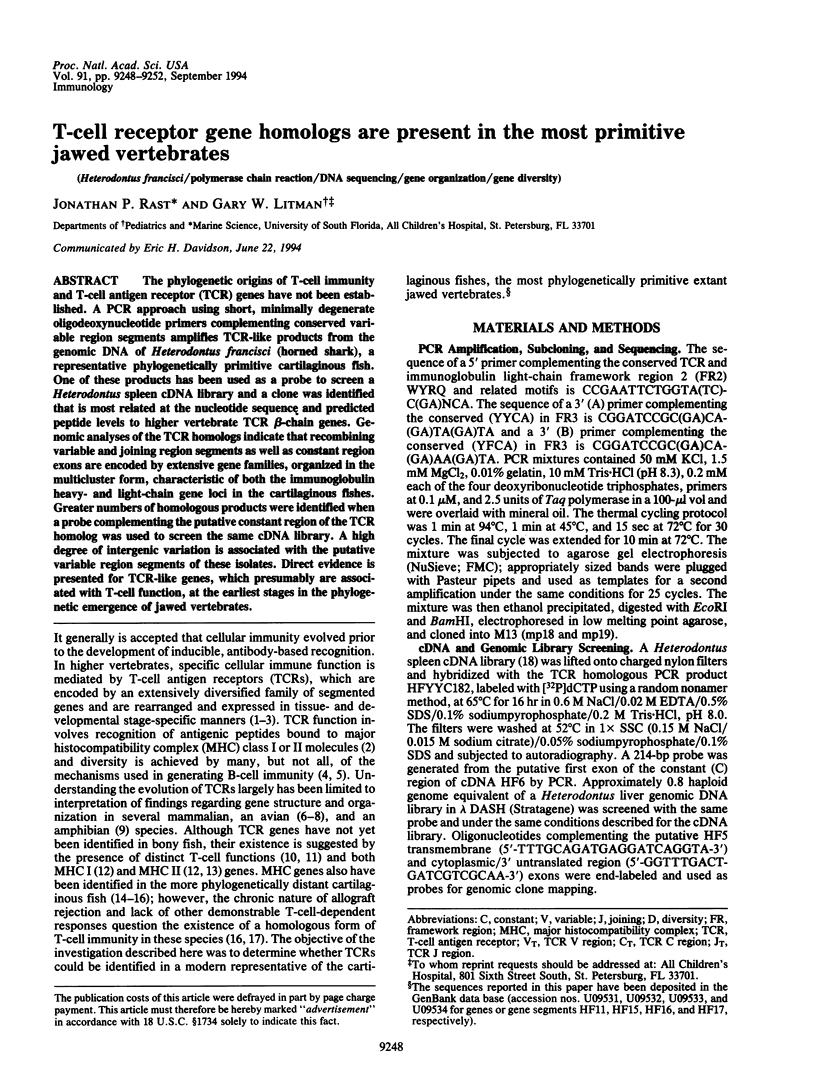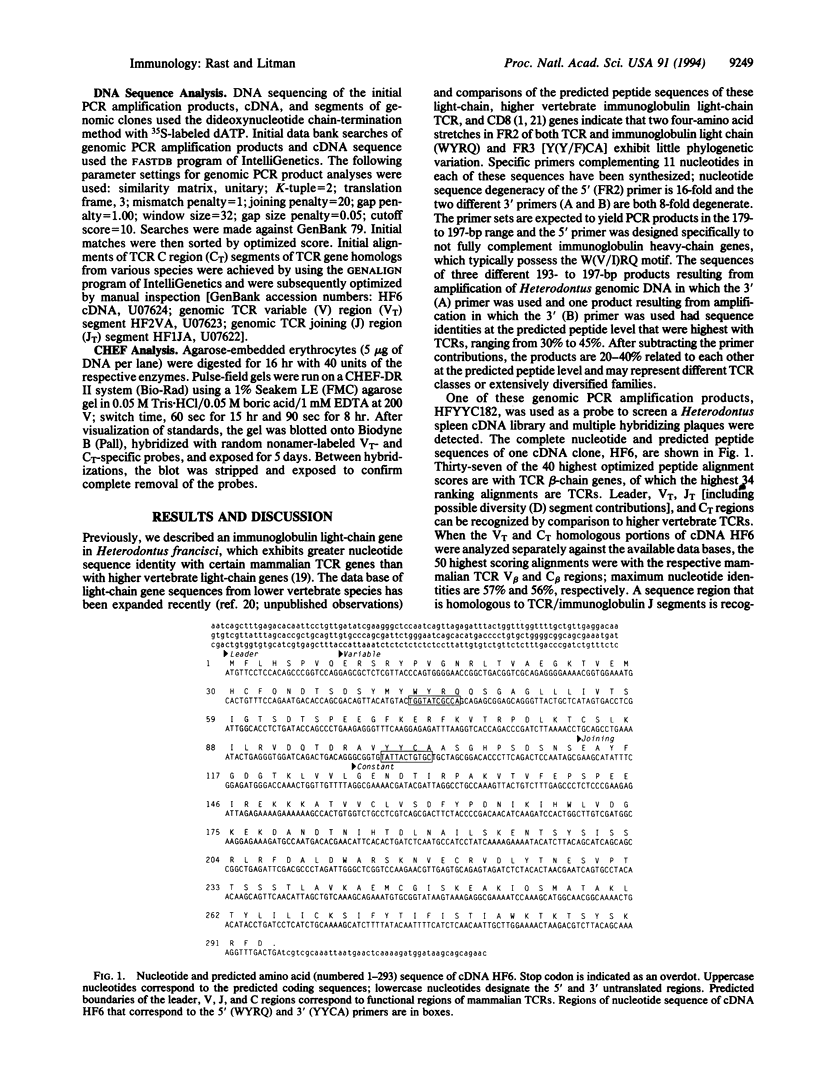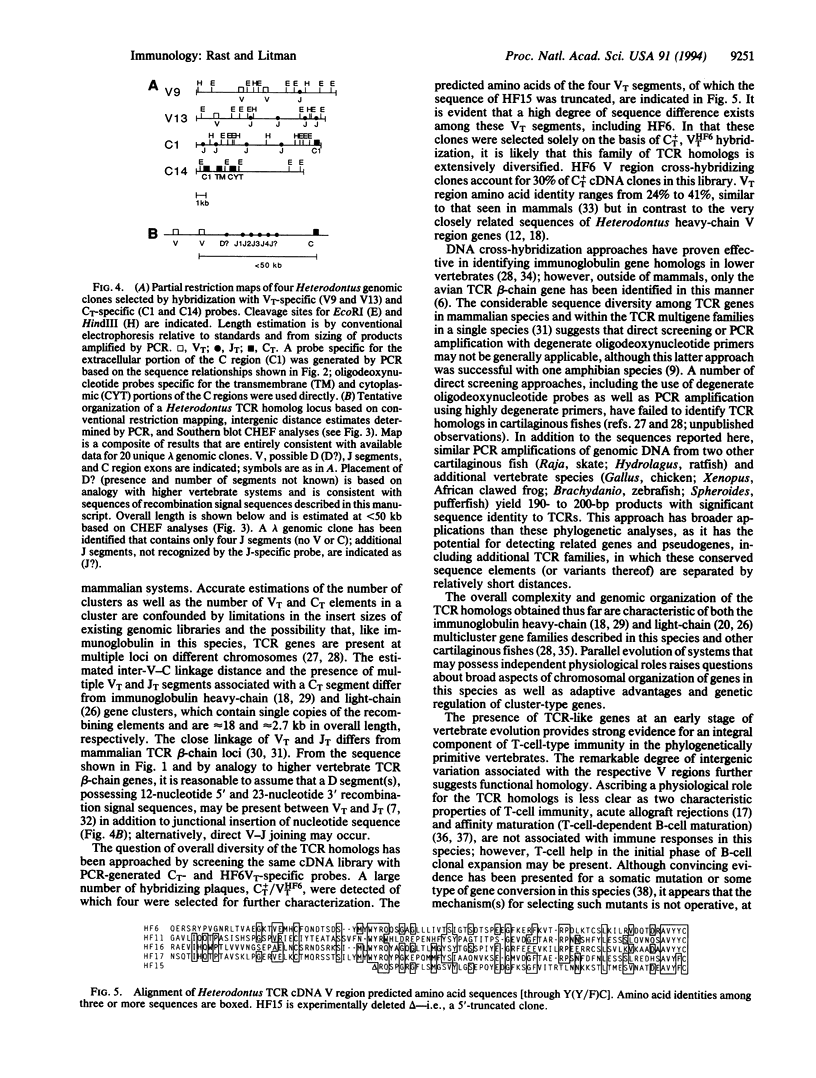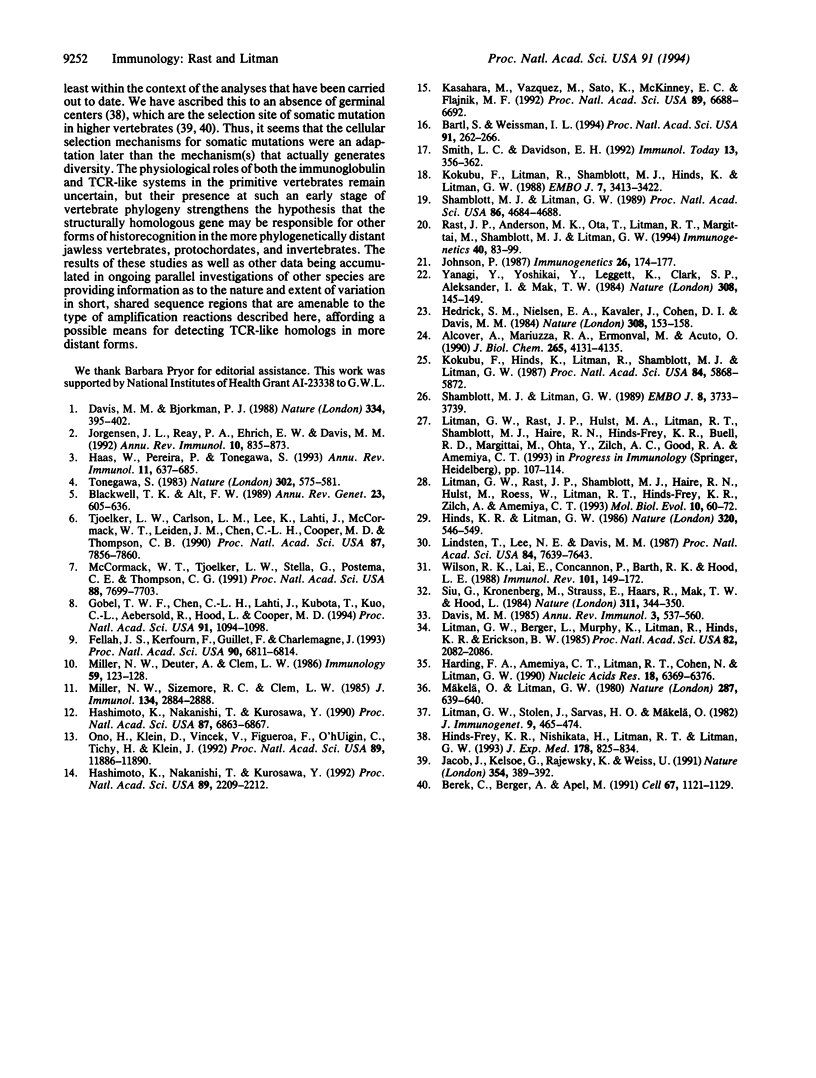Abstract
The phylogenetic origins of T-cell immunity and T-cell antigen receptor (TCR) genes have not been established. A PCR approach using short, minimally degenerate oligodeoxynucleotide primers complementing conserved variable region segments amplifies TCR-like products from the genomic DNA of Heterodontus francisci (horned shark), a representative phylogenetically primitive cartilaginous fish. One of these products has been used as a probe to screen a Heterodontus spleen cDNA library and a clone was identified that is most related at the nucleotide sequence and predicted peptide levels to higher vertebrate TCR beta-chain genes. Genomic analyses of the TCR homologs indicate that recombining variable and joining region segments as well as constant region exons are encoded by extensive gene families, organized in the multicluster form, characteristic of both the immunoglobulin heavy- and light-chain gene loci in the cartilaginous fishes. Greater numbers of homologous products were identified when a probe complementing the putative constant region of the TCR homolog was used to screen the same cDNA library. A high degree of intergenic variation is associated with the putative variable region segments of these isolates. Direct evidence is presented for TCR-like genes, which presumably are associated with T-cell function, at the earliest stages in the phylogenetic emergence of jawed vertebrates.
Full text
PDF




Images in this article
Selected References
These references are in PubMed. This may not be the complete list of references from this article.
- Alcover A., Mariuzza R. A., Ermonval M., Acuto O. Lysine 271 in the transmembrane domain of the T-cell antigen receptor beta chain is necessary for its assembly with the CD3 complex but not for alpha/beta dimerization. J Biol Chem. 1990 Mar 5;265(7):4131–4135. [PubMed] [Google Scholar]
- Bartl S., Weissman I. L. Isolation and characterization of major histocompatibility complex class IIB genes from the nurse shark. Proc Natl Acad Sci U S A. 1994 Jan 4;91(1):262–266. doi: 10.1073/pnas.91.1.262. [DOI] [PMC free article] [PubMed] [Google Scholar]
- Berek C., Berger A., Apel M. Maturation of the immune response in germinal centers. Cell. 1991 Dec 20;67(6):1121–1129. doi: 10.1016/0092-8674(91)90289-b. [DOI] [PubMed] [Google Scholar]
- Blackwell T. K., Alt F. W. Mechanism and developmental program of immunoglobulin gene rearrangement in mammals. Annu Rev Genet. 1989;23:605–636. doi: 10.1146/annurev.ge.23.120189.003133. [DOI] [PubMed] [Google Scholar]
- Davis M. M., Bjorkman P. J. T-cell antigen receptor genes and T-cell recognition. Nature. 1988 Aug 4;334(6181):395–402. doi: 10.1038/334395a0. [DOI] [PubMed] [Google Scholar]
- Davis M. M. Molecular genetics of the T cell-receptor beta chain. Annu Rev Immunol. 1985;3:537–560. doi: 10.1146/annurev.iy.03.040185.002541. [DOI] [PubMed] [Google Scholar]
- Fellah J. S., Kerfourn F., Guillet F., Charlemagne J. Conserved structure of amphibian T-cell antigen receptor beta chain. Proc Natl Acad Sci U S A. 1993 Jul 15;90(14):6811–6814. doi: 10.1073/pnas.90.14.6811. [DOI] [PMC free article] [PubMed] [Google Scholar]
- Göbel T. W., Chen C. L., Lahti J., Kubota T., Kuo C. L., Aebersold R., Hood L., Cooper M. D. Identification of T-cell receptor alpha-chain genes in the chicken. Proc Natl Acad Sci U S A. 1994 Feb 1;91(3):1094–1098. doi: 10.1073/pnas.91.3.1094. [DOI] [PMC free article] [PubMed] [Google Scholar]
- Haas W., Pereira P., Tonegawa S. Gamma/delta cells. Annu Rev Immunol. 1993;11:637–685. doi: 10.1146/annurev.iy.11.040193.003225. [DOI] [PubMed] [Google Scholar]
- Haire R. N., Buell R. D., Litman R. T., Ohta Y., Fu S. M., Honjo T., Matsuda F., de la Morena M., Carro J., Good R. A. Diversification, not use, of the immunoglobulin VH gene repertoire is restricted in DiGeorge syndrome. J Exp Med. 1993 Sep 1;178(3):825–834. doi: 10.1084/jem.178.3.825. [DOI] [PMC free article] [PubMed] [Google Scholar]
- Harding F. A., Amemiya C. T., Litman R. T., Cohen N., Litman G. W. Two distinct immunoglobulin heavy chain isotypes in a primitive, cartilaginous fish, Raja erinacea. Nucleic Acids Res. 1990 Nov 11;18(21):6369–6376. doi: 10.1093/nar/18.21.6369. [DOI] [PMC free article] [PubMed] [Google Scholar]
- Hashimoto K., Nakanishi T., Kurosawa Y. Identification of a shark sequence resembling the major histocompatibility complex class I alpha 3 domain. Proc Natl Acad Sci U S A. 1992 Mar 15;89(6):2209–2212. doi: 10.1073/pnas.89.6.2209. [DOI] [PMC free article] [PubMed] [Google Scholar]
- Hashimoto K., Nakanishi T., Kurosawa Y. Isolation of carp genes encoding major histocompatibility complex antigens. Proc Natl Acad Sci U S A. 1990 Sep;87(17):6863–6867. doi: 10.1073/pnas.87.17.6863. [DOI] [PMC free article] [PubMed] [Google Scholar]
- Hedrick S. M., Nielsen E. A., Kavaler J., Cohen D. I., Davis M. M. Sequence relationships between putative T-cell receptor polypeptides and immunoglobulins. Nature. 1984 Mar 8;308(5955):153–158. doi: 10.1038/308153a0. [DOI] [PubMed] [Google Scholar]
- Hinds K. R., Litman G. W. Major reorganization of immunoglobulin VH segmental elements during vertebrate evolution. Nature. 1986 Apr 10;320(6062):546–549. doi: 10.1038/320546a0. [DOI] [PubMed] [Google Scholar]
- Jacob J., Kelsoe G., Rajewsky K., Weiss U. Intraclonal generation of antibody mutants in germinal centres. Nature. 1991 Dec 5;354(6352):389–392. doi: 10.1038/354389a0. [DOI] [PubMed] [Google Scholar]
- Johnson P. A human homolog of the mouse CD8 molecule, Lyt-3: genomic sequence and expression. Immunogenetics. 1987;26(3):174–177. doi: 10.1007/BF00365908. [DOI] [PubMed] [Google Scholar]
- Jorgensen J. L., Reay P. A., Ehrich E. W., Davis M. M. Molecular components of T-cell recognition. Annu Rev Immunol. 1992;10:835–873. doi: 10.1146/annurev.iy.10.040192.004155. [DOI] [PubMed] [Google Scholar]
- Kasahara M., Vazquez M., Sato K., McKinney E. C., Flajnik M. F. Evolution of the major histocompatibility complex: isolation of class II A cDNA clones from the cartilaginous fish. Proc Natl Acad Sci U S A. 1992 Aug 1;89(15):6688–6692. doi: 10.1073/pnas.89.15.6688. [DOI] [PMC free article] [PubMed] [Google Scholar]
- Kokubu F., Hinds K., Litman R., Shamblott M. J., Litman G. W. Extensive families of constant region genes in a phylogenetically primitive vertebrate indicate an additional level of immunoglobulin complexity. Proc Natl Acad Sci U S A. 1987 Aug;84(16):5868–5872. doi: 10.1073/pnas.84.16.5868. [DOI] [PMC free article] [PubMed] [Google Scholar]
- Kokubu F., Litman R., Shamblott M. J., Hinds K., Litman G. W. Diverse organization of immunoglobulin VH gene loci in a primitive vertebrate. EMBO J. 1988 Nov;7(11):3413–3422. doi: 10.1002/j.1460-2075.1988.tb03215.x. [DOI] [PMC free article] [PubMed] [Google Scholar]
- Lindsten T., Lee N. E., Davis M. M. Organization of the T-cell antigen-receptor beta-chain locus in mice. Proc Natl Acad Sci U S A. 1987 Nov;84(21):7639–7643. doi: 10.1073/pnas.84.21.7639. [DOI] [PMC free article] [PubMed] [Google Scholar]
- Litman G. W., Berger L., Murphy K., Litman R., Hinds K., Erickson B. W. Immunoglobulin VH gene structure and diversity in Heterodontus, a phylogenetically primitive shark. Proc Natl Acad Sci U S A. 1985 Apr;82(7):2082–2086. doi: 10.1073/pnas.82.7.2082. [DOI] [PMC free article] [PubMed] [Google Scholar]
- Litman G. W., Rast J. P., Shamblott M. J., Haire R. N., Hulst M., Roess W., Litman R. T., Hinds-Frey K. R., Zilch A., Amemiya C. T. Phylogenetic diversification of immunoglobulin genes and the antibody repertoire. Mol Biol Evol. 1993 Jan;10(1):60–72. doi: 10.1093/oxfordjournals.molbev.a040000. [DOI] [PubMed] [Google Scholar]
- Litman G. W., Stolen J. S., Sarvas H. O., Mäkelä O. The range and fine specificity of the anti-hapten immune response: phylogenetic studies. J Immunogenet. 1982 Dec;9(6):465–474. doi: 10.1111/j.1744-313x.1982.tb01008.x. [DOI] [PubMed] [Google Scholar]
- McCormack W. T., Tjoelker L. W., Stella G., Postema C. E., Thompson C. B. Chicken T-cell receptor beta-chain diversity: an evolutionarily conserved D beta-encoded glycine turn within the hypervariable CDR3 domain. Proc Natl Acad Sci U S A. 1991 Sep 1;88(17):7699–7703. doi: 10.1073/pnas.88.17.7699. [DOI] [PMC free article] [PubMed] [Google Scholar]
- Miller N. W., Deuter A., Clem L. W. Phylogeny of lymphocyte heterogeneity: the cellular requirements for the mixed leucocyte reaction with channel catfish. Immunology. 1986 Sep;59(1):123–128. [PMC free article] [PubMed] [Google Scholar]
- Miller N. W., Sizemore R. C., Clem L. W. Phylogeny of lymphocyte heterogeneity: the cellular requirements for in vitro antibody responses of channel catfish leukocytes. J Immunol. 1985 May;134(5):2884–2888. [PubMed] [Google Scholar]
- Mäkelä O., Litman G. W. Lack of heterogeneity in antihapten antibodies of a phylogenetically primitive shark. Nature. 1980 Oct 16;287(5783):639–640. doi: 10.1038/287639a0. [DOI] [PubMed] [Google Scholar]
- Ono H., Klein D., Vincek V., Figueroa F., O'hUigin C., Tichy H., Klein J. Major histocompatibility complex class II genes of zebrafish. Proc Natl Acad Sci U S A. 1992 Dec 15;89(24):11886–11890. doi: 10.1073/pnas.89.24.11886. [DOI] [PMC free article] [PubMed] [Google Scholar]
- Rast J. P., Anderson M. K., Ota T., Litman R. T., Margittai M., Shamblott M. J., Litman G. W. Immunoglobulin light chain class multiplicity and alternative organizational forms in early vertebrate phylogeny. Immunogenetics. 1994;40(2):83–99. doi: 10.1007/BF00188170. [DOI] [PubMed] [Google Scholar]
- Shamblott M. J., Litman G. W. Complete nucleotide sequence of primitive vertebrate immunoglobulin light chain genes. Proc Natl Acad Sci U S A. 1989 Jun;86(12):4684–4688. doi: 10.1073/pnas.86.12.4684. [DOI] [PMC free article] [PubMed] [Google Scholar]
- Shamblott M. J., Litman G. W. Genomic organization and sequences of immunoglobulin light chain genes in a primitive vertebrate suggest coevolution of immunoglobulin gene organization. EMBO J. 1989 Dec 1;8(12):3733–3739. doi: 10.1002/j.1460-2075.1989.tb08549.x. [DOI] [PMC free article] [PubMed] [Google Scholar]
- Siu G., Kronenberg M., Strauss E., Haars R., Mak T. W., Hood L. The structure, rearrangement and expression of D beta gene segments of the murine T-cell antigen receptor. 1984 Sep 27-Oct 3Nature. 311(5984):344–350. doi: 10.1038/311344a0. [DOI] [PubMed] [Google Scholar]
- Smith L. C., Davidson E. H. The echinoid immune system and the phylogenetic occurrence of immune mechanisms in deuterostomes. Immunol Today. 1992 Sep;13(9):356–362. doi: 10.1016/0167-5699(92)90172-4. [DOI] [PubMed] [Google Scholar]
- Tjoelker L. W., Carlson L. M., Lee K., Lahti J., McCormack W. T., Leiden J. M., Chen C. L., Cooper M. D., Thompson C. B. Evolutionary conservation of antigen recognition: the chicken T-cell receptor beta chain. Proc Natl Acad Sci U S A. 1990 Oct;87(20):7856–7860. doi: 10.1073/pnas.87.20.7856. [DOI] [PMC free article] [PubMed] [Google Scholar]
- Tonegawa S. Somatic generation of antibody diversity. Nature. 1983 Apr 14;302(5909):575–581. doi: 10.1038/302575a0. [DOI] [PubMed] [Google Scholar]
- Wilson R. K., Lai E., Concannon P., Barth R. K., Hood L. E. Structure, organization and polymorphism of murine and human T-cell receptor alpha and beta chain gene families. Immunol Rev. 1988 Jan;101:149–172. doi: 10.1111/j.1600-065x.1988.tb00736.x. [DOI] [PubMed] [Google Scholar]
- Yanagi Y., Yoshikai Y., Leggett K., Clark S. P., Aleksander I., Mak T. W. A human T cell-specific cDNA clone encodes a protein having extensive homology to immunoglobulin chains. Nature. 1984 Mar 8;308(5955):145–149. doi: 10.1038/308145a0. [DOI] [PubMed] [Google Scholar]



